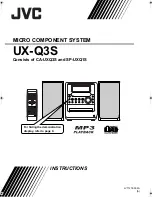
Revision A • 6/06
H
A
R
R
I
S
C
O
R
P
O
R
A T
I
O
N
3-11
3 Using NetWave
will be assigned to one of the external monitor
inputs. The other external input typically is from
a synthetic air signal to simulate the air signal
processing, but without any delay. Alternately, one
of the program buses may be monitored for a non-
delayed signal.
Two channel sources may be assigned as Telco
inputs. These are special channel sources, with
added functionality, that are covered in more de-
tail in the following sections.
TELCO / CODEC OPERATION
Each NetWave console can have two channel
sources set as Telco 1 and Telco 2. Typically, the
inputs come from telephone callers or from live
remotes (in the NetWave “Telco” refers to any type
of two-way device, including telephone hybrids,
satellite transceivers, ISDN codecs and two-way
radios).
Each Telco device has a Caller, or From Net-
work, output that connects to the Telco channel
input. A NetWave
mix-minus output then connects
the console back to the Send, or To Network, in-
put on the Telco device.
The console’s two mix-minus outputs are also
called foldback outputs. No matter which bus is
assigned to these outputs, the audio is always mi-
nus the Telco audio (hence the term mix-minus).
On earlier analog consoles, this mix-minus out-
put would be manually created by the board op-
erator through bus assignments, but on the Net-
Wave the mix-minus output is always correctly
derived by the console, regardless of which bus is
selected on the two Telco channels.
Since the board operator can also talk to either
mix-minus output, the outputs are also called IFBs
(for Interruptible Fold Back outputs). The board
operator can talk to either mix-minus output by
pressing and holding that Telco channel’s active
On or Off button. The button blinks rapidly while
pressed to indicate talkback is active.
Linked NetWave consoles have two dual-chan-
nel mix-minus outputs that go to the VistaMax
system. One channel is the same IFB mix-minus
output as from the console, while the second is a
clean feed mix-minus output. To use this dual mix-
minus output, the console must be linked to a Vis-
taMax system and the Telco device’s Send, or To
Network, input must be connected to a VistaMax
or Envoy I/O card. This type of connection is most
often used with dual channel ISDN remotes where
the IFB output goes to the talent headphones at
the remote while the clean feed goes to a PA sys-
tem at the remote broadcast site.
The two Telco channel sources should have been
identified by custom labels during installation (in
lieu of the standard A and B labels). But, if not,
the two Telco channels have one distinctive fea-
ture: one bus assignment button will be winking
because, on the two Telco channels, the bus as-
signment buttons are multipurpose. They not only
assign the Telco channel to one or more buses,
they also set which bus is used to create the mix-
minus signal. In addition, the buttons also iden-
TEL 1 TEL 2
A winking button
(lit/dim/lit) indicates
the mix-minus source
and the source for the
record mix bus
A blinking button
(lit/off/lit) indicates
the mix-minus source
as well, but it also says
the Telco channel will
not be recorded since
it is not the record mix
bus
With Telco 2 off, press
and hold the Off button
to talk to Telco 2
With Telco 1 on,
press and hold the
On button to talk
to Telco 1
When a Program bus is
the mix-minus source,
the audio is post-switch
and post-fader for
all channels.
When Offline is the mix-
minus source, the signals
are normally pre-fader
(they can be set as post-
fader during console
setup). Offline is always
pre-switch.
Telco Channel Features
















































